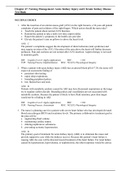Exam (elaborations)
NURSING NR 324 Chapter 47;: Nursing Management: Acute Kidney Injury and Chronic Kidney Disease. Q&A
- Course
- NURSING NR 324
- Institution
- Chamberlain College Of Nursing
MULTIPLE CHOICE 1. After the insertion of an arteriovenous graft (AVG) in the right forearm, a 54-year-old patient complains of pain and coldness of the right fingers. Which action should the nurse take? a. Teach the patient about normal AVG function. b. Remind the patient to take a daily low-d...
[Show more]



